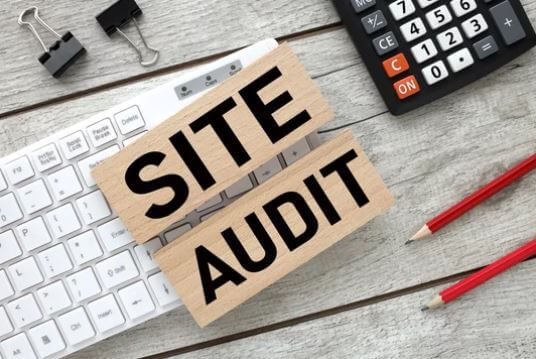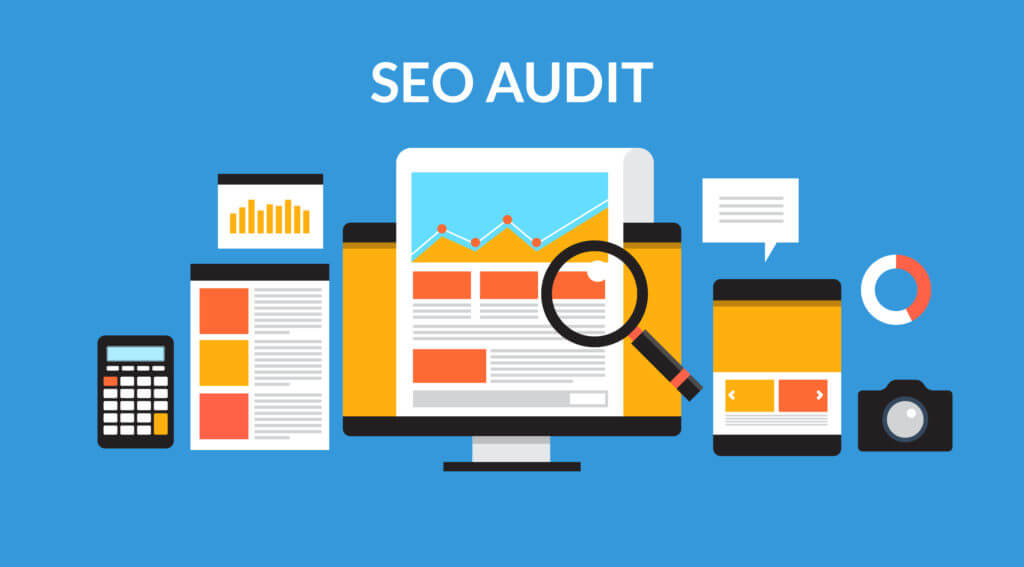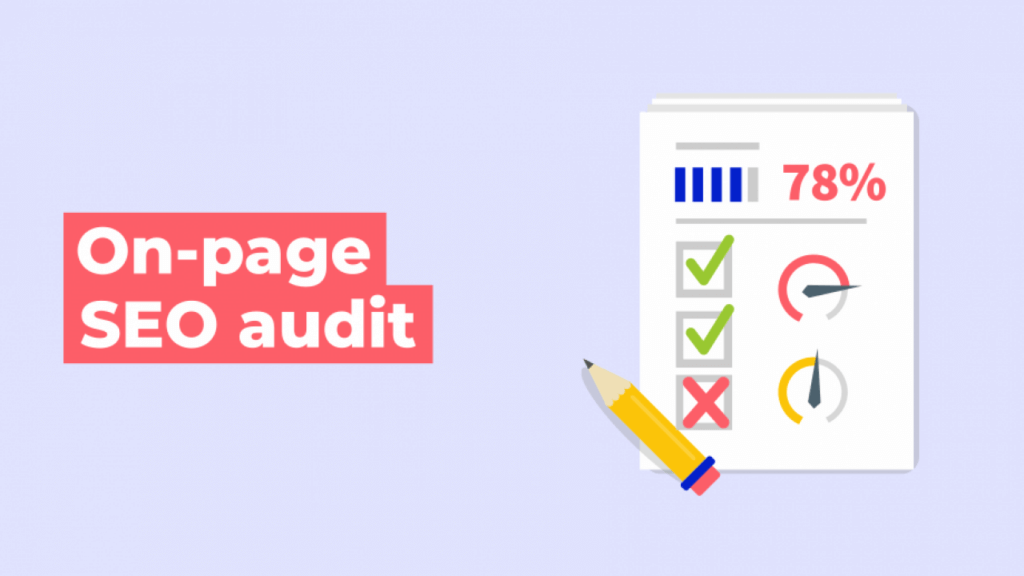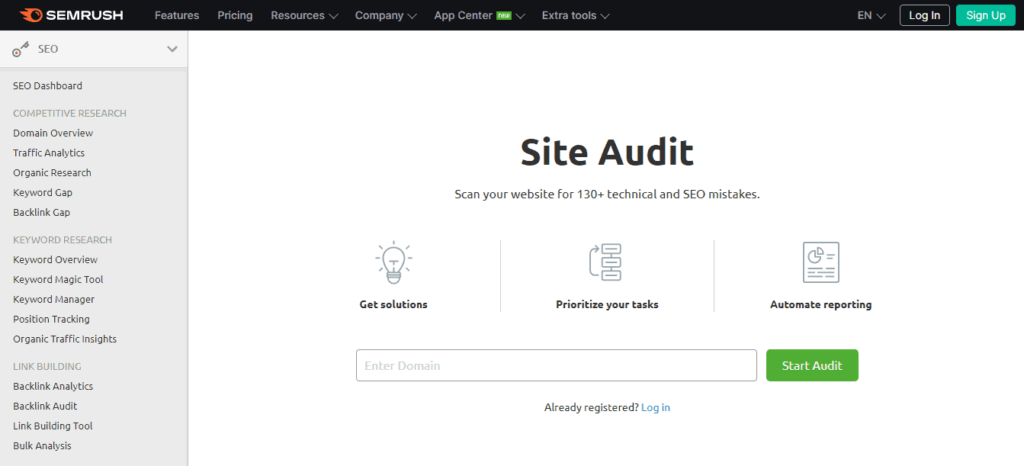Site Audit
Introduction
A site audit is an essential process that involves a comprehensive analysis of a website’s technical, on-page, off-page, and content aspects. It aims to identify potential issues and areas of improvement that could help optimize a website’s performance and enhance its user experience. A site audit can be performed manually or using specialized tools that automate the process.
A site audit aims to provide website owners with a detailed report of their site’s strengths, weaknesses, and opportunities. The information should contain actionable insights that can help improve the website’s overall health, increase its visibility in search engines, and attract more traffic. Website owners can make informed decisions about their digital marketing strategies and investments by conducting a site audit.
There are several benefits of conducting a site audit, including:
- Improved Search Engine Optimization (SEO) – A site audit can help identify technical and on-page SEO issues affecting a website’s ranking in search engine results pages (SERPs). By addressing these issues, website owners can improve their SEO performance and attract more organic traffic.
- Enhanced User Experience – A site audit can help identify usability and accessibility issues affecting a website’s user experience. By addressing these issues, website owners can improve overall usability and make it more accessible to a broader audience.
- Increased Website Security – A site audit can help identify security vulnerabilities that may put a website and its users at risk. By addressing these vulnerabilities, website owners can improve their site’s security and protect their users’ personal information.
- Better Conversion Rates – A site audit can help identify content and design issues affecting a website’s conversion rates. By addressing these issues, website owners can improve their site’s overall conversion rate and generate more leads or sales.
Now that we’ve covered the benefits of a site audit, let’s take a closer look at the aspects typically covered in a site audit.
Technical SEO
Technical SEO refers to optimizing a website’s technical elements to improve its visibility in search engines. A thorough technical SEO audit can help identify any issues affecting a website’s performance and help improve its overall health.
Here are some of the aspects that are typically evaluated in a technical SEO audit:
A. URL Structure
A website’s URL structure is an essential aspect of technical SEO as it can affect its visibility in search engines. A site audit should examine the website’s URL structure to ensure that it is consistent, descriptive, and user-friendly. URLs should be easy to read and indicate the page’s content. They should also contain the target keyword, where possible.
B. Site Speed
Site speed is essential in technical SEO as it can affect a website’s ranking in search engine results pages (SERPs) and user experience. A site audit should evaluate the website’s loading speed to ensure it is fast enough to provide a smooth user experience. Slow loading speeds can lead to a higher bounce rate and negatively impact a website’s SEO performance.
C. Mobile Responsiveness
Mobile responsiveness is another critical aspect of technical SEO, as it can affect a website’s ranking in mobile search results and user experience. A site audit should evaluate the website’s mobile responsiveness to ensure that it is optimized for mobile devices and provides a seamless browsing experience. Mobile-responsive websites are easier to use on smaller screens and provide a better user experience.
D. Site Architecture
Site architecture refers to the organization and structure of a website’s content. A site audit should evaluate the website’s architecture to ensure it is organized, intuitive, and easy to navigate. A clear and well-structured site architecture can help search engines understand a website’s content and improve its ranking in SERPs.
E. Site Map
A site map is a document that lists all the pages on a website. A site audit should evaluate the website’s map to ensure it is updated and contains all the relevant pages. A well-organized site map can help search engines crawl a website more effectively and improve its ranking in SERPs.
F. Robots.txt
A robots.txt file is a document that tells search engine crawlers which pages or sections of a website to crawl or avoid. A site audit should evaluate the website’s robots.txt file to ensure it is properly configured and does not block any important pages. Misconfigured robots.txt files can lead to indexing issues and negatively impact a website’s SEO performance.
G. Duplicate Content
Duplicate content refers to content that appears on more than one page of a website or multiple websites. A site audit should evaluate the website’s content to ensure no duplicate pages or content that may harm its SEO performance. The same content can confuse search engines and negatively impact a website’s ranking in SERPs.
H. Broken Links
Broken links refer to links on a website that no longer work or lead to an error page. A site audit should evaluate the website’s links to ensure no broken links may affect its user experience or SEO performance. Broken links can lead to a higher bounce rate and negatively impact a website’s SEO performance.
I. Redirects
Redirects are used to direct users from one URL to another. A site audit should evaluate the website’s redirects to ensure they are correctly configured and not causing any issues. Misconfigured redirects can lead to indexing issues and negatively impact a website’s SEO performance.
J. Canonical URLs
Canonical URLs refer to the preferred URL version that search engines should use when indexing a website’s content.
On-page SEO
On-page SEO refers to optimizing a website’s content to improve its visibility in search engines. A thorough on-page SEO audit can help identify any issues affecting a website’s performance and help improve its overall health.
Here are some of the aspects that are typically evaluated in an on-page SEO audit:
A. Keyword Research
Keyword research is an essential aspect of on-page SEO as it can help identify the search terms that users use to find products or services related to a website’s content. A site audit should evaluate the website’s keyword research to ensure the target keywords are relevant and optimized throughout the range.
B. Meta Descriptions
Meta descriptions are HTML attributes that briefly summarize a page’s content. A site audit should evaluate the website’s meta descriptions to ensure they are relevant, descriptive, and contain the target keyword. Meta descriptions can influence a user’s decision to click on a link in search results, so optimizing them properly is essential.
C. Title Tags
Title tags are HTML elements that briefly and concisely describe a page’s content. A site audit should evaluate the website’s title tags to ensure they are relevant, descriptive, and contain the target keyword. Title tags are an important on-page SEO element influencing a website’s ranking in search results.
D. Header Tags
Header tags are HTML elements that structure a page’s content hierarchically. A site audit should evaluate the website’s header tags to ensure they are correctly used and contain the target keyword. Header tags can help organize a page’s content and improve its readability.
E. Content Optimization
Content optimization refers to improving a website’s content to make it more relevant and valuable to users. A site audit should evaluate the website’s content optimization to ensure the content is relevant, informative, and properly optimized for the target keywords. Well-optimized content can help improve a website’s ranking in search results and attract more traffic.
F. Image Optimization
Image optimization refers to optimizing images to make them more accessible and relevant to users. A site audit should evaluate the website’s image optimization to ensure the images are correctly sized, labeled, and optimized for search engines. Well-optimized ideas can improve a website’s user experience and attract more traffic.
G. Internal Linking
Internal linking refers to linking to other pages within a website. A site audit should evaluate the website’s internal linking to ensure it is used correctly and effectively. Internal linking can help organize a website’s content, improve its user experience, and help search engines understand the content of a website.
H. Call-to-Actions
Call-to-actions (CTAs) encourage users to take a specific action, such as filling out a form or purchasing. A site audit should evaluate the website’s CTAs to ensure they are correctly placed, relevant, and effective. Well-designed and effective CTAs can improve a website’s conversion rate and generate more leads or sales.
A thorough on-page SEO audit can help identify any issues affecting a website’s performance and help improve its overall health. By evaluating the website’s keyword research, meta descriptions, title tags, header tags, content optimization, image optimization, internal linking, and call-to-actions, a site audit can help improve a website’s ranking in search results, attract more traffic, and generate more leads or sales.
Off-page SEO
Off-page SEO refers to optimizing a website’s external factors to improve its visibility in search engines. A thorough off-page SEO audit can help identify any issues affecting a website’s performance and help improve its overall health.
Here are some of the aspects that are typically evaluated in an off-page SEO audit:
A. Backlinks
Backlinks are links from other websites that point to a website. Backlinks are essential in off-page SEO as they can improve a website’s authority and ranking in search results. A site audit should evaluate the website’s backlinks to ensure they are relevant, high-quality, and not spammy.
B. Social Media
Social media can be an effective way to promote a website and increase its visibility. A site audit should evaluate the website’s social media presence to ensure it is optimized and used effectively. Social media can help drive traffic to a website, improve its authority, and increase its engagement with users.
C. Local SEO
Local SEO optimizes a website’s regional presence to improve its visibility in local search results. A site audit should evaluate the website’s local SEO to ensure it is correctly optimized for local search terms, has accurate and up-to-date information on local directories, and is correctly linked to Google My Business.
D. Reputation Management
Reputation management manages a website’s online reputation by monitoring and responding to reviews, comments, and mentions. A site audit should evaluate the website’s reputation management to ensure it appropriately monitors and responds to reviews and comments on various platforms. Reputation management can help improve a website’s reputation, attract customers, and improve its search ranking.
A thorough off-page SEO audit can help identify any issues affecting a website’s performance and help improve its overall health. By evaluating the website’s backlinks, social media presence, local SEO, and reputation management, a site audit can help improve a website’s authority, ranking, and reputation in search results.
Content Audit
Content is a critical component of any website, and a content audit can help identify any issues affecting a website’s performance and help improve its overall health. A content audit involves analyzing a website’s content, including blog posts, product pages, and landing pages, to evaluate its relevance, quality, and effectiveness.
Here are some of the aspects that are typically evaluated in a content audit:
A. Overview of Content Audit
Before diving into the specifics, it’s essential to understand a content audit’s overall purpose and methodology. A site audit should provide an overview of what a content audit entails, why it’s necessary, and how it can help improve a website’s performance.
B. Content Relevance
Content relevance refers to how a website’s content aligns with its intended audience and purpose. A site audit should evaluate its content relevance to ensure it targets the right audience, answers their questions, and provides value.
C. Content Quality
Content quality refers to the overall quality of the content on a website, including its accuracy, comprehensiveness, and readability. A site audit should evaluate the website’s content quality to ensure it is well-written, engaging, and error-free.
D. Content Formatting
Content formatting refers to how the content on a website is presented, including its layout, use of headings, and use of images and videos. A site audit should evaluate the website’s content formatting to ensure it is easy to read, visually appealing, and optimized for user experience.
E. Content Frequency
Content frequency refers to the rate at which new content is published on a website. A site audit should evaluate the website’s content frequency to ensure it publishes new content regularly and consistently.
F. Content Strategy
Content strategy refers to the overall plan for creating and publishing content on a website. A site audit should evaluate the website’s content strategy to ensure it aligns with its goals, target audience, and marketing objectives.
A thorough content audit can help identify any is affecting a website’s performance and help improve its overall health. By evaluating the website’s content relevance, quality, formatting, frequency, and strategy, a site audit can help improve the website’s user experience, attract more traffic, and generate more leads or sales.
Analytics
Analytics measures and analyzes website data to understand user behavior, track performance, and make informed decisions. A thorough analytics audit can help identify issues affecting a website’s performance and help improve its overall health.
Here are some of the aspects that are typically evaluated in an analytics audit:
A. Tracking Code Implementation
Tracking code implementation includes installing and configuring website tracking codes like Google Analytics. A site audit should evaluate the website’s tracking code implementation to ensure it is properly installed, configured and provides accurate data.
B. Data Accuracy
Data accuracy refers to the correctness and reliability of the data collected by the website’s tracking codes. A site audit should evaluate the website’s data accuracy to ensure that the data being collected is reliable, free from errors, and properly filtered.
C. Goals and Conversions
Goals and conversions refer to users’ actions on a website, such as filling out a form or purchasing. A site audit should evaluate the website’s plans and modifications to ensure they are correctly set up and tracked and provide meaningful insights.
D. Traffic Sources
Traffic sources are how users access websites through organic search, social media, or paid advertising. A site audit should evaluate the website’s traffic sources to understand where most of the traffic is coming from and identify opportunities for improvement.
E. User Behavior
User behavior refers to user actions on a website, such as page views, time spent, and bounce rate. A site audit should evaluate the website’s user behavior to understand how users interact with the website and identify areas for improvement.
F. Mobile Traffic
Mobile traffic refers to the traffic accessing the website from mobile devices. A site audit should evaluate the website’s mobile traffic to understand the percentage of traffic coming from mobile devices and ensure the website is correctly optimized for mobile users.
Analytics audits can help identify issues affecting a website’s performance and help improve its overall health. By evaluating the website’s tracking code implementation, data accuracy, goals, conversions, traffic sources, user behavior, and mobile traffic, a site audit can help improve the website’s user experience, attract more traffic, and generate more leads or sales.
Conclusion
A site audit is a comprehensive evaluation of a website’s technical, on-page, off-page, content, and analytics components to identify any issues affecting its performance and improve its overall health. A site audit can help improve a website’s visibility in search engines, attract traffic, and generate more leads or sales.
Here are some key takeaways from each section of a site audit:
Technical SEO
- A thorough evaluation of a website’s technical elements, including its URL structure, site speed, mobile responsiveness, site architecture, site map, robots.txt, duplicate content, broken links, redirects, and canonical URLs, can help improve its visibility in search engines and provide a smooth user experience.
On-Page SEO
- A thorough evaluation of a website’s on-page elements, including its keyword research, meta descriptions, title tags, header tags, content optimization, image optimization, internal linking, and call-to-actions, can help improve its ranking in search results, attract more traffic, and generate more leads or sales.
Off-Page SEO
- A thorough evaluation of a website’s off-page elements, including its backlinks, social media presence, local SEO, and reputation management, can help improve its authority, ranking, and reputation in search results.
Content Audit
- A thorough evaluation of a website’s content, including its relevance, quality, formatting, frequency, and strategy, can help improve its user experience, attract more traffic, and generate more leads or sales.
Analytics
- A thorough evaluation of a website’s analytics, including its tracking code implementation, data accuracy, goals, conversions, traffic sources, user behavior, and mobile traffic, can help improve its user experience, attract more traffic, and generate more traffic leads or sales.
A site audit is essential for identifying issues affecting a website’s performance and improving its health. By thoroughly evaluating a website’s technical, on-page, off-page, content, and analytics components, a site audit can help improve a website’s visibility in search engines, attract more traffic, and generate more leads or sales.
F.A.Q
How to conduct a technical SEO site audit?
Conducting a technical SEO site audit is essential in improving your website’s performance and visibility in search engines. Here are some steps to follow when conducting a technical SEO site audit:
- Check Your Website’s URL Structure: Make sure your website’s URL structure is clean, user-friendly, and optimized for search engines.
- Evaluate Your Website’s Site Speed: Check your website’s load times and identify any factors slowing it down, such as large image sizes or too many plugins.
- Ensure Your Website is Mobile-Friendly: With more and more users accessing the internet via mobile devices, it’s essential to ensure your website is mobile-friendly and responsive.
- Check Your Website’s Site Architecture: Your website’s architecture should be well-organized and easy for users and search engines to navigate.
- Verify Your Site Map and Robots.txt File: Ensure your website has a properly formatted XML sitemap and a robots.txt file to help search engines crawl and index your website.
- Check for Duplicate Content: Duplicate content can hurt your website’s SEO. Use a tool to identify any instances of duplicate content on your website.
- Identify and Fix Broken Links: Broken links can hurt your website’s user experience and SEO. Use a tool to identify and fix any broken links on your website.
- Address Redirects and Canonical URLs: Ensure your website has proper redirects in place and that your canonical URLs are correctly implemented.
Following these steps, you can conduct a thorough technical SEO site audit and identify any issues affecting your website’s performance and visibility in search engines. Once you’ve identified these issues, please take the necessary steps to address them and improve your website’s SEO.
When should the site audit be performed?
A site audit should be performed regularly to ensure your website functions optimally and meets your business goals. The frequency of the site audit can vary depending on your website’s size, its structure’s complexity, and the frequency of updates or changes. Here are some general guidelines for when to perform a site audit:
- When You Launch a New Website: It’s essential to perform a site audit when you launch a new website to ensure that everything is working as intended, there are no technical issues, and your website is optimized for search engines.
- Quarterly or Bi-Annual Audits: Depending on the size and complexity of your website, it’s a good practice to perform a site audit every quarter or every six months to ensure that your website is up-to-date and performing optimally.
- After Major Website Updates: If you’ve made significant updates to your website, such as a redesign or migration, it’s essential to perform a site audit to ensure that everything is working as intended and there are no technical issues.
- When You Experience a Drop in Traffic or Ranking: If you notice a significant drop in traffic or search engine rankings, performing a site audit to identify any issues affecting your website’s performance is essential.
By performing regular site audits, you can ensure that your website is up-to-date, performing optimally, and meeting your business goals. If you’re unsure how often you should perform a site audit, consult an SEO professional who can provide guidance based on your specific needs and goals.
What is a site audit tool?
A site audit tool is a software or online service that helps analyze and evaluate a website’s health and performance. Site audit tools use a variety of metrics and data points to identify issues and provide recommendations for improvement. Here are some of the features that are typically included in a site audit tool:
- Technical SEO Analysis: Site audit tools evaluate a website’s technical components, such as site speed, URL structure, mobile-friendliness, site architecture, site map, robots.txt, duplicate content, broken links, redirects, and canonical URLs, to ensure that the website is optimized for search engines.
- On-Page SEO Analysis: Site audit tools evaluate a website’s on-page components, such as keyword research, meta descriptions, title tags, header tags, content optimization, image optimization, internal linking, and call-to-actions, to ensure that the website is correctly optimized for search engines and provides a good user experience.
- Off-Page SEO Analysis: Site audit tools evaluate a website’s off-page components, such as backlinks, social media presence, local SEO, and reputation management, to assess the website’s authority, ranking, and reputation in search results.
- Content Analysis: Site audit tools evaluate a website’s content, such as relevance, quality, formatting, frequency, and strategy, to identify any issues affecting the website’s user experience, traffic, and engagement.
- Analytics Analysis: Site audit tools evaluate a website’s analytics, such as tracking code implementation, data accuracy, goals, conversions, traffic sources, user behavior, and mobile traffic, to identify any issues affecting the website’s user experience, traffic, and engagement.
Site audit tools can provide valuable insights and recommendations for improving a website’s performance, search engine visibility, and user experience. Some famous site audit tools include SEMrush, Ahrefs, Moz, Google Search Console, and Screaming Frog.







